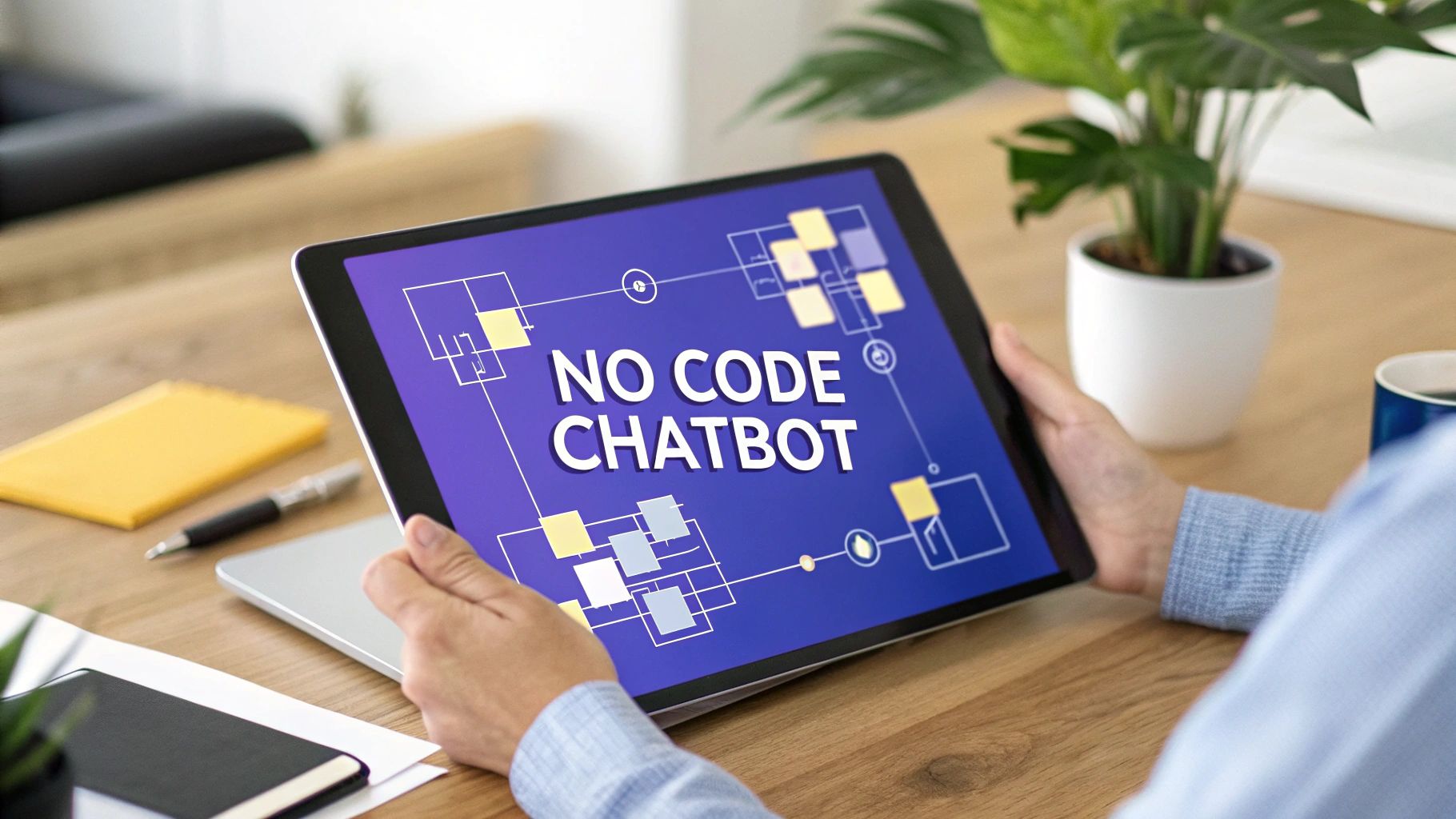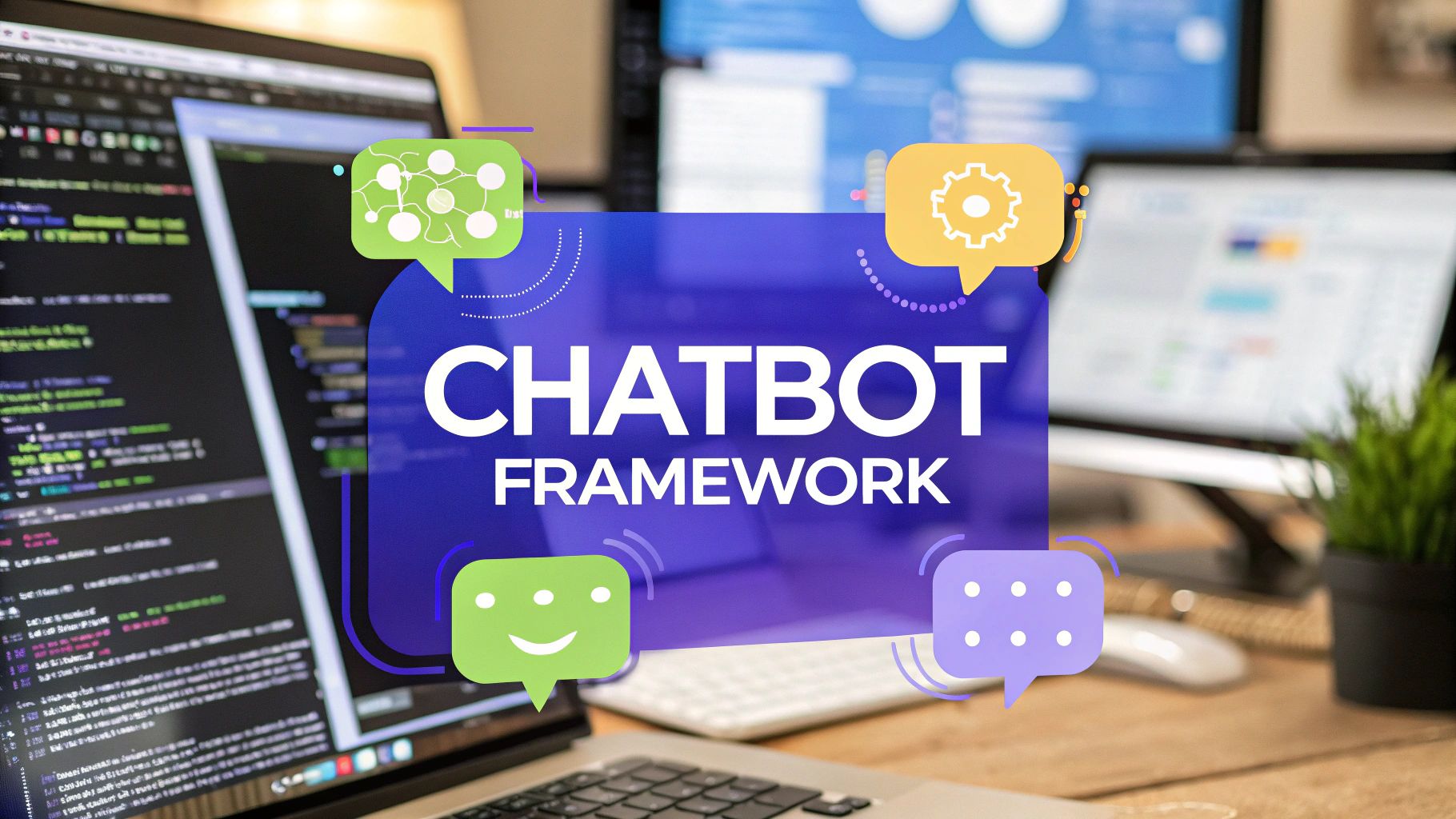Build a Bot with a No Code Chatbot Builder
Discover how a no code chatbot builder can automate your customer service. Learn about key features, real-world uses, and how to choose the right tool.

A no-code chatbot builder is a tool that lets your team create and launch automated chatbots without having to write a single line of code. Instead, you get a visual, drag-and-drop interface to design conversations, making powerful AI accessible to anyone.
What Exactly Is a No Code Chatbot Builder?
Think of a no-code chatbot builder as a set of LEGO blocks for conversations. You do not need to engineer the bot from scratch; you just snap together pre-built pieces to create a fully functional conversational assistant.
These platforms do all the heavy lifting on the backend, so you can focus entirely on designing helpful and engaging interactions for your customers. If you have ever used drag and drop website builders, the concept is very similar. They took complex web development and made it simple for everyone.
How These Builders Work
The core idea is refreshingly simple: you show the platform what you want the bot to do, and it handles the rest. This process boils down to a few key steps that anyone, regardless of technical skill, can follow.
Here’s a look at the basic mechanics:
- Visual Flow Editor: You map out conversations on a drag-and-drop canvas, connecting different responses and actions to create a logical path for the user to follow.
- Pre-built Templates: Most builders come with ready-to-use templates for common tasks like capturing leads, scheduling meetings, or answering frequently asked questions.
- AI and NLP Integration: The platform comes with built-in artificial intelligence and natural language processing (NLP) to figure out what users are really asking for and provide the right answers.
This approach puts the power of automation directly into the hands of the people who know your customers best: your marketers, sales teams, and customer support staff.
A no-code chatbot builder removes the technical barriers to automation. It allows businesses to deploy helpful bots in hours or days, not months, dramatically reducing development costs and time to market.
You no longer need a team of developers or a massive budget to get started. With a user-friendly interface, you can design, test, and launch a bot that works around the clock. To get started, you can learn more about how to create your own chatbot with a no-code platform and start improving customer service and generating leads more efficiently.
Why Your Business Should Use a No Code Chatbot

So, now you know what a no code chatbot builder is. The next logical question is, why should you care? The short answer is that these tools do more than just automate conversations. They fundamentally improve how you talk to customers and run your business.
One of the first things you will notice is a huge boost in customer support. Your chatbot can be online 24/7, instantly answering common questions about your products, shipping policies, or services. No more making customers wait for an email reply or sit on hold.
This frees up your human support team to stop answering the same questions over and over. Instead, they can pour their energy into solving the complex, high-stakes issues that actually require a human touch.
Drive Growth and Efficiency
Beyond just handling support tickets, a no code chatbot can become a serious engine for growth. It can greet website visitors, ask qualifying questions to identify hot leads, and even book demos right on the spot. It turns your passive website traffic into an active sales pipeline.
Automating a big chunk of those customer conversations also has a massive impact on your bottom line. In fact, businesses can cut their customer support costs by automating up to 70% of interactions, making it a smart and efficient investment. You can learn more about the trends driving no-code chatbot adoption to see why so many businesses are making the switch.
No Code Chatbots Compared to Traditional Development
To really see the business case, it helps to see how no code platforms stack up against coding a chatbot from scratch.
As you can see, no code builders make chatbot technology far more accessible, letting you move faster and save money without sacrificing quality.
The biggest advantage is that your existing team, the people who already know your business inside and out, can build and manage the chatbot. There is no need to hire expensive developers or wait months for a custom-coded solution.
This is what makes it such a practical tool for businesses of any size. To make sure your bot is actually answering the questions people are asking, it is a good idea to brush up on the principles of Answer Engine Optimization. With the right approach, you can launch a bot that saves money, boosts efficiency, and makes your customers happier all at once.
Must-Have Features in a No Code Builder

Not all no-code chatbot builders are created equal. To find a tool that actually makes your life easier, you need to know what to look for. The best platforms turn what used to be a complicated technical process into something simple and intuitive.
At the heart of any great no-code chatbot builder is its visual flow editor. This is your canvas, a drag-and-drop interface where you map out the entire conversation. Think of it like drawing a flowchart. You connect different questions, answers, and actions to create a clear path for the user.
This visual-first approach is what removes the need for programming skills. You can see exactly how the bot will behave just by looking at the flow you have designed.
Core Capabilities for Success
A pretty drag-and-drop interface is just the start. The real power comes from the tools that help you build smarter, faster bots. Your checklist should definitely include these items:
- Pre-built Templates: Why start from scratch? Look for a library of templates for common jobs like lead capture, appointment booking, or answering FAQs. These give you a functional starting point that you can customize in minutes, not hours.
- Easy Integrations: A chatbot should not be an island. It needs to connect to the other tools you already use, your CRM, email marketing platform, or helpdesk, to be genuinely useful.
- Analytics and Reporting: You can’t improve what you don’t measure. A solid analytics dashboard shows you how many people use your bot, what they’re asking, and where conversations might be hitting a snag.
The ability to seamlessly integrate with tools you already use is what transforms a simple chatbot into a core part of your business operations. It allows the bot to pull customer data, create support tickets, or add leads to your sales pipeline automatically.
Finally, strong analytics give you the insights to refine your bot’s responses over time. You can see what’s working, what is not, and make adjustments to improve its performance. For a closer look at what modern tools offer, explore our guide on the no-code AI agent builder landscape.
Real-World Examples of No Code Chatbots
Theory is one thing, but seeing how no-code chatbots perform in the wild is where their value really clicks. Businesses across all sorts of industries are using these tools to solve specific problems, smooth out customer interactions, and just plain operate more efficiently.

Think about an e-commerce store. A chatbot on its website can instantly handle the most common question imaginable: "Where's my order?" By connecting to the store’s backend systems, the bot can give real-time status updates, freeing up the support team to handle more complex issues.
That same bot can also step in as a personal shopper. It might ask a customer a few simple questions and then recommend products based on their answers. This guides the customer to the right purchase and often nudges the average order value up for the business.
From Real Estate to Software Support
Now, let's picture a real estate agency. A chatbot on its site can greet potential homebuyers the moment they arrive, asking a few pre-qualifying questions about their budget, preferred location, and must-have features.
Based on those answers, the bot can even schedule property viewings directly on an agent’s calendar. It automates that first layer of lead qualification, making sure agents spend their valuable time with serious, well-matched clients.
Another great example comes from the software world. A software-as-a-service (SaaS) company might use a chatbot to handle frontline technical support. The bot can walk users through basic troubleshooting for common glitches, often solving the problem on the spot without needing a human agent.
These practical applications show that no-code chatbots are more than just a novelty. They are flexible tools that businesses are using to automate key functions, from lead generation to customer service, driving real and measurable results.
Chatbots have become so common that 88% of customers report having interacted with one, and for many, the experience is totally seamless. The conversations can feel so natural that users do not even realize they’re talking to a bot. To get a better sense of this shift, you can read more about the growing chatbot market.
Ultimately, these examples show just how adaptable a no-code chatbot builder can be in meeting unique business needs.
How to Choose the Right No Code Chatbot Platform
With dozens of options on the market, picking the right no-code chatbot builder can feel like a chore. The secret is not to get distracted by flashy features. It is to start with a clear goal in mind.
What, exactly, do you need this chatbot to do for you? Are you trying to qualify more sales leads from your website? Or maybe you just want to stop answering the same five customer support questions over and over again. Defining your primary objective first makes it much easier to weed out platforms that are not a good fit.
Evaluate the Essentials
Once you know what you need, it is time to get practical. How easy is the platform to actually use? Most builders offer a free trial. You should absolutely take advantage of it.
If the interface feels clunky or confusing after a few hours, that’s a big red flag. The whole point of a no-code chatbot builder is to let your team build without needing developers, so the user experience should be simple and intuitive right from the start.
Another critical piece of the puzzle is integrations. Your chatbot is useless if it can't talk to the other software your business depends on, like your CRM or email marketing tools.
- Check for Native Integrations: Does the builder connect directly with tools like HubSpot, Salesforce, or Mailchimp? This makes passing data back and forth smooth and automatic.
- Confirm API Access: For more advanced needs, check if the platform has an API. This gives you the flexibility to build custom connections if a native one does not exist.
- Test the Connections: During your trial period, try setting up one or two of your most important integrations. See for yourself how seamless the process really is.
Finally, think about the future. Take a close look at the pricing models and scalability. Find a tool that fits your budget today and also has a clear path for growth as your business expands. Getting a handle on the technical options can also be useful; our guide on chatbot development frameworks offers a deeper look.
Still Have Questions?
Got a few last questions about what a no-code chatbot builder can do for you? Here are some quick, direct answers to the ones we hear the most.
Can I Really Build a Smart Chatbot Without Knowing How to Code?
Yes, absolutely. Modern no-code builders come packed with sophisticated artificial intelligence and natural language processing (NLP). You handle the fun part, designing the conversation in a visual editor, and the platform takes care of all the technical heavy lifting behind the scenes.
This means you can create intelligent, responsive chatbots that actually understand what users are asking for, all without writing a single line of code.
How Long Does It Take to Get a Chatbot Live?
It really depends on what you need it to do. You can get a simple FAQ bot up and running in just a few hours, especially if you start with a pre-built template.
A more advanced bot, say, one that qualifies sales leads and connects to your CRM, might take a couple of days to set up and test thoroughly. Either way, it’s worlds faster than traditional development, which can easily stretch into weeks or even months.
The rise of these platforms is part of a much bigger trend. The broader no-code development market is projected to hit $84.47 billion by 2027, and this shift is expected to reduce the demand for traditional coding skills in some areas by up to 40%. You can dig into more insights about the no-code revolution here.
Are No-Code Chatbots Secure?
Reputable no-code platforms take security very seriously. They typically offer features like data encryption and compliance with regulations like GDPR. When you are looking at different options, just take a moment to review their security policies to make sure they line up with your company's standards.
Ready to see what a no-code AI agent can do for your business? With Chatiant, you can create a custom chatbot trained on your own data in minutes. Build your Chatiant bot today.


